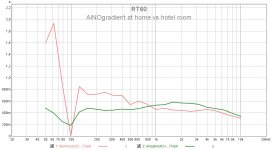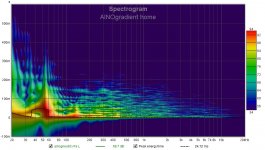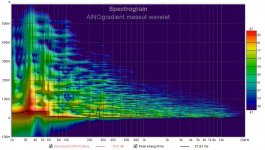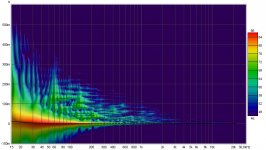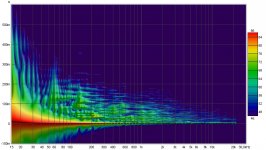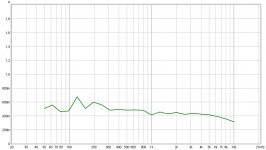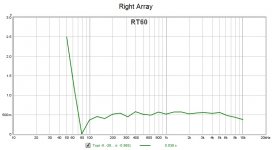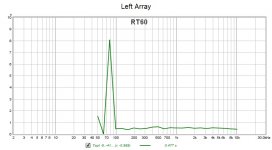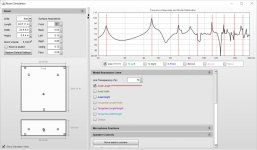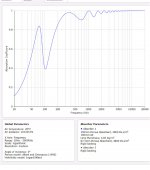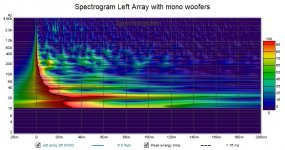I have actually tried multisub with tree units, but that was without dsp and measurements.
Recently I have been using Minidsp units without FIR and phase tuning. Three sets have two closed box subwoofers as bottom of multiway speakers, crossed around 200Hz LR2. My HT room has only one 2x15" sub playing summed L+R signal below 80Hz LR2. With all systems I get pretty smooth response from 20-30 Hz up, but with wiggles. Sounds more natural to my ears that way.
I don't use roomEQ for modes at all, only as tone control with low Q. I have tried roomEQ for spot and multiple measurements, but abandoned that. I mostly listen to music, movie rumbles come finely too, but are irrelevant for me.
Mark100 - I can't sit in the spot either!
Recently I have been using Minidsp units without FIR and phase tuning. Three sets have two closed box subwoofers as bottom of multiway speakers, crossed around 200Hz LR2. My HT room has only one 2x15" sub playing summed L+R signal below 80Hz LR2. With all systems I get pretty smooth response from 20-30 Hz up, but with wiggles. Sounds more natural to my ears that way.
I don't use roomEQ for modes at all, only as tone control with low Q. I have tried roomEQ for spot and multiple measurements, but abandoned that. I mostly listen to music, movie rumbles come finely too, but are irrelevant for me.
Mark100 - I can't sit in the spot either!
I think you always get one spot equalized. The challenge is to do that over a wider area but a single spot is better than nothing. Fortunately, when I'm walking around I'm not that critical.
Things are looking better today. I moved some panels and nulls both shrank and moved. Since I need panels both locations for the moved panels, I'm going to build a couple more before I do anything else.
Things are looking better today. I moved some panels and nulls both shrank and moved. Since I need panels both locations for the moved panels, I'm going to build a couple more before I do anything else.
On reflection, rereading this before posting...I guess there is a third method as suggested by Ron...specific tuning to a specific spot. Probably used my most.
I wish I could get into that again, but after ditching electrostatic sweet spot listening 20 years ago...well hell, I haven't even listened while sitting down in years. This old man like to move 🙂
With wavelengths this long you have a certain amount of freedom. But that doesn't mean to have it perfect in a sweet spot while neglecting the area around it. That's why I would look at the performance of the sub by itself and the array by itself over the area of interest. That could determine what part is played by which driver(s).
Now nc535 is relying on a crossover as the array doesn't go down to cover low notes, but that does not mean the sub can't still help the arrays above it's crossover to make up for weak area's of the array, one can do it separately for each side.
This doesn't have to create a cloud of sound, just keep an eye on the wavelet, Fr, IR and phase. If you do it right you still get/keep that punchy tight bass. Relative differences are more important than actual distance. Playing with sound setup in a car sure though me that. This can still be made to work over a larger area. Personally, I wouldn't use anything that falls apart off axis. Getting rid of the early stuff is mandatory though, and what nc535 has concentrated on. Personally I would have tried to push the arrays closer to the side walls, still well away from the wall behind it to get the troubled output lower in frequency. At least have a solid difference in distances (array to side wall, array to wall behind it) to balance it.
For me the 100-200 Hz is quite important to get right, as that will enhance the punch. It is a bad area to have problems in. A Pure symmetric setup could double the trouble there. Play with these factors like placement to shift it far enough to not coincide.
Room enough to experiment before committing.
Last edited:
Good point about wall distance. I haven't moved arrays around a lot but have modeled with Vituix and it didn't show me a better place than what I have, just tradeoffs between null here vs there.
I was hoping/expecting my absorber panels would give me more immunity to side and front wall distances. I've realized recently that isn't quite the case. Those freestanding absorbers seem to resonate with the wall behind leading to a combing like absorption vs frequency curve. and they would benefit from being thicker.
I could put a rigid backing on them, which would probably help quite a bit. Lows would no longer go through but would/could diffract around increasing path length to wall reflection by width of panel and maybe also decreasing intensity. I did one quick and dirty experiment with a partial backing panel and didn't like the result but I discount that bad result because it was so quick and dirty.
So many things to try and limited energy. Unlike M100 who can't sit still, I'm not hyper active🙂. Hats off to him. I think he is on his 4th build already this year.
I was hoping/expecting my absorber panels would give me more immunity to side and front wall distances. I've realized recently that isn't quite the case. Those freestanding absorbers seem to resonate with the wall behind leading to a combing like absorption vs frequency curve. and they would benefit from being thicker.
I could put a rigid backing on them, which would probably help quite a bit. Lows would no longer go through but would/could diffract around increasing path length to wall reflection by width of panel and maybe also decreasing intensity. I did one quick and dirty experiment with a partial backing panel and didn't like the result but I discount that bad result because it was so quick and dirty.
So many things to try and limited energy. Unlike M100 who can't sit still, I'm not hyper active🙂. Hats off to him. I think he is on his 4th build already this year.
what I was doing in pulling arrays so far from side wall (besides accommodating all the stuff in the room) was pulling the first null down into subwoofer territory where I could apply spatial diversity. This only works if I have absorption so I don't get nulls at harmonics of that first null. which means my absorbers have to be effective down to 200 Hz, which they are not quite......
Had this conversation before with BYRTT - original concept was to be right up against a wall or corner where 1" or 2" absorption would suffice.
how do you guys think my garage door would look/work with pink fluffy insulation glued to its inside surface between the wind support girders?
Had this conversation before with BYRTT - original concept was to be right up against a wall or corner where 1" or 2" absorption would suffice.
how do you guys think my garage door would look/work with pink fluffy insulation glued to its inside surface between the wind support girders?
In the pic it looks like walls, floor and ceiling are solid and the door is aluminium panels. So the door is practically transparent for bass frequencies and all other walls reflect 100%. Adding insulation to the door should not do anything for bass (unless it rattles)
Looks like your listening height is close to ½ of the room - difficult considering first vertical mode. Movable panels do practically nothing for bass either. Make other of solid side walls to work as bass trap - fake board-wall with at least 2' of loose stuffing with insulation wool. There is no height enough to do the same for ceiling...
I like this simulator - you can add several subs and adjust height of speakers and mic
hunecke.de | Loudspeakers Calculator
Looks like your listening height is close to ½ of the room - difficult considering first vertical mode. Movable panels do practically nothing for bass either. Make other of solid side walls to work as bass trap - fake board-wall with at least 2' of loose stuffing with insulation wool. There is no height enough to do the same for ceiling...
I like this simulator - you can add several subs and adjust height of speakers and mic
hunecke.de | Loudspeakers Calculator
Last edited:
Thanks for the link; been wishing for a room response simulator better than REW's.
In garage two walls are block, interior wall opposite garage door and ceiling are sheetrock iwth fiberglass insulation. I can build bass traps into those 2' deep shelves behind speakers. But I need to retain a lot of that space for storage.
What do you think about two layers of sheetrock green-glued together for bass damping? That is something I could do without giving up a lot of space.
In garage two walls are block, interior wall opposite garage door and ceiling are sheetrock iwth fiberglass insulation. I can build bass traps into those 2' deep shelves behind speakers. But I need to retain a lot of that space for storage.
What do you think about two layers of sheetrock green-glued together for bass damping? That is something I could do without giving up a lot of space.
OK. Opposing hard walls are the biggest problem for you,so damp the other one first.Thicness is crucial.
Have you looked at RT60 values? In my home downstairs has block walls and upstairs has wood frame with plasterboad, also inner walls with insulation and outer walls are 1' thick (Scandinavia you know...)
Here is RT and wavelet of my room and a hotel room with concrete walls.
Have you looked at RT60 values? In my home downstairs has block walls and upstairs has wood frame with plasterboad, also inner walls with insulation and outer walls are 1' thick (Scandinavia you know...)
Here is RT and wavelet of my room and a hotel room with concrete walls.
Attachments
Last edited:
OK. Opposing hard walls are the biggest problem for you,so damp the other one first.Thicness is crucial.
Have you looked at RT60 values? In my home downstairs has block walls and upstairs has wood frame with plasterboad, also inner walls with insulation and outer walls are 1' thick (Scandinavia you know...)
Here is RT and wavelet of my room and a hotel room with concrete walls.
In designing my damping panels I had 3 primary inputs I concentrated on. The IR to determine where I needed panels. RT60 to see where the excess energy was. I also made FR graphs that showed a filtered frequency response (smoothed with psy filter at that time), filtered to start at 50 ms out to 500 to, again determine the area where I had excess energy. In my room it was clearly down to at least ~200 Hz, which made me decide to have a thickness of 3" fiberglass insulation (covered on both sides with wool felt) on the side walls, with an air gap between panel and wall. The one behind the listener is 2" thickness and disguised as a poster. Again using wool felt on both sides and a little air gap behind the panel (only about a cm here as it would look strange otherwise).
End result with DSP involved:
(no normalization, room curve applied)
(with normalization)
Tight enough bass? I do believe so. I could never have got there without the damping panels. I still have plans to improve on overall performance with the addition of a couple of subs.
I did not want to create a dead anechoic like room, I tried to follow some guide lines as mentioned by Linkwitz to get RT60 around 4-500 ms.
With a bit of luck I actually got quite close. With the ambient channels on, the graphs are actually a little bit better. I posted about that on my thread somewhere quite some time ago.Linkwitz in the Orion project: said:Room acoustics: Fairly live with RT60 of 400 ms to 700 ms
I'm guessing nc535 should be able to get close to my results. I don't even have panels on the wall behind the arrays, tried some measurements with and without: no big advantage there for me. I had expected bigger problems at low frequencies though. I may have gotten lucky with my room specifics.
It might work to have the panels slightly off of the (side)wall, not hugging the speaker, so make the speaker free standing. Panels at first reflection points on the wall (with air gap). I don't regret the free standing speakers as moving them around and aiming them sure seemed to help a lot.
I think the key is to use all the info we get. The IR (even better with using the filters in problem areas) will show the effectiveness to reduce reflections. I moved panels around my room to find the specifics while taking measurements. Their thickness can help quite a lot to clean up overall room response. I needed to hide them as much as possible in our living room, while I can still think of some improvements, I had to promise not to put up any more panels, got to know when to listen to the missus.
DSP was used to optimize final results, but it's way less forced than most would assume. The panels do quite some heavy lifting (as they should).
The wall behind the listener is a rigid wall, the one behind the arrays has more flex, as it's an old house (1927), there's insulation and gypsum panels with stucco on that wall.
Valid point on the ceiling height though, I'm at 2.7 M ceiling height here, listening position around the 1 M height mark.
Attachments
Last edited:
A bass trap for that left and right array suddenly seems logical.
Excess energy on one side where the other side shows a suck out...
Together they will sum a little better but that left side is scary...
Excess energy on one side where the other side shows a suck out...
Together they will sum a little better but that left side is scary...
Where would I place that bass trap and how big? how many?
Last night I was looking at limp membrane trap that can be tuned to 70 hz. Apparently, per multi layer absorber calculator I can incorporatea porous absorber in front of the membrane and get tuned as well as broadband absorption but with a gap
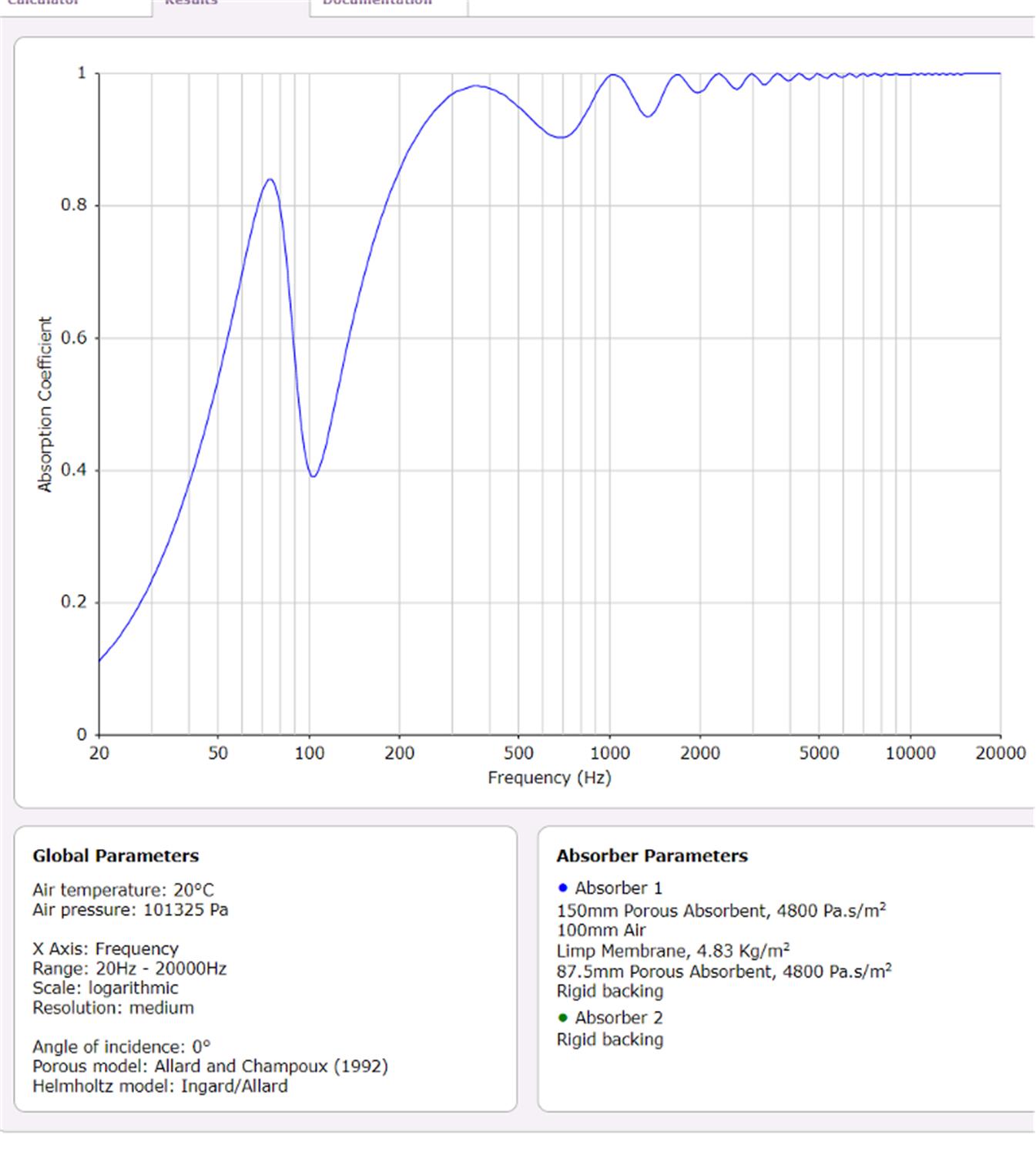
such a thing would be about 14" thick and could go beside or behind the array in place of the marginally effective panels I have there now. I would hate to have to line an entire wall with these.
Last night I was looking at limp membrane trap that can be tuned to 70 hz. Apparently, per multi layer absorber calculator I can incorporatea porous absorber in front of the membrane and get tuned as well as broadband absorption but with a gap
such a thing would be about 14" thick and could go beside or behind the array in place of the marginally effective panels I have there now. I would hate to have to line an entire wall with these.
Attachments
Sorry I have never studied bass traps etc., but I guess more surface coverage of the wall in question is better. Your right wall in the sim is the garage door?
Where would I place that bass trap and how big? how many?
Last night I was looking at limp membrane trap that can be tuned to 70 hz. Apparently, per multi layer absorber calculator I can incorporatea porous absorber in front of the membrane and get tuned as well as broadband absorption but with a gap
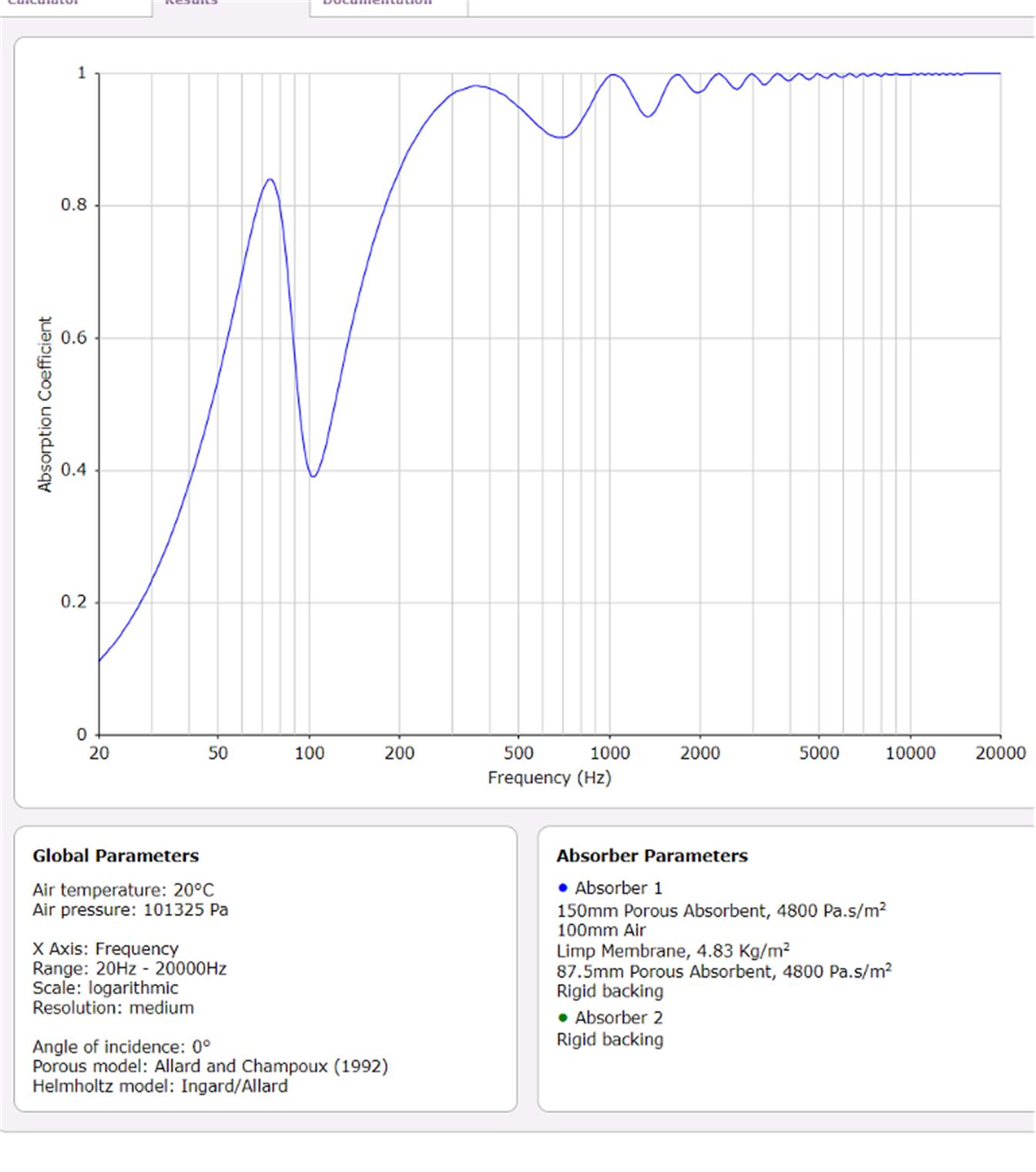
such a thing would be about 14" thick and could go beside or behind the array in place of the marginally effective panels I have there now. I would hate to have to line an entire wall with these.
My guess would be both corners behind the arrays or the corners of the opposite wall. I would check though, what the arrays do by themselves RT60 wise. Easier to whip something up with the fluffy kind of fiberglass isolation. I'd go for simple panels on first reflection points, stuffing the corner with a bit more material (if possible).
I guess it will take some experimenting.
Last edited:
Re experimentation - classic understatement
I move my old corner bass traps from mid rear wall to side of left array and everything changes. Need to build a couple more so I can have them both places.
re designing traps - I'm learning. the online calculators give me likely false confidence. Problem is the resonant traps are very narrow band so more opportunity for "experimentation".
I move my old corner bass traps from mid rear wall to side of left array and everything changes. Need to build a couple more so I can have them both places.
re designing traps - I'm learning. the online calculators give me likely false confidence. Problem is the resonant traps are very narrow band so more opportunity for "experimentation".
yes right wall in sim is garage door
continued with that. got decent response with rear woofer delayed 9 ms. Went out and tried it and got best response with rear woofer delay 9 ms AND INVERTED 🙂
continued with that. got decent response with rear woofer delayed 9 ms. Went out and tried it and got best response with rear woofer delay 9 ms AND INVERTED 🙂
So here is that frequency response with mono woofers, rear channel inverted and delayed 9 ns.
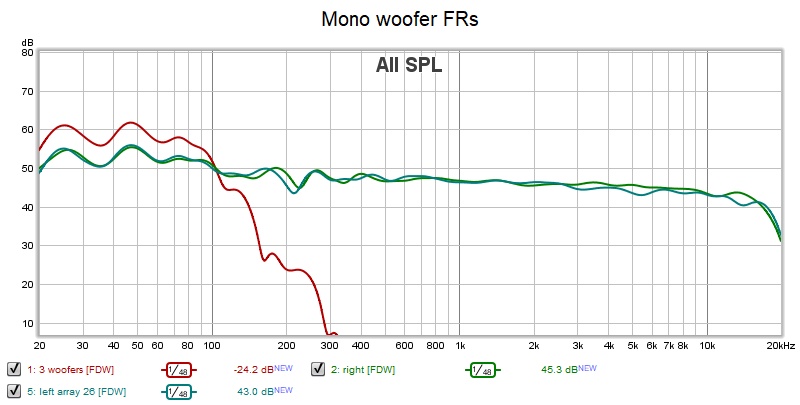
are here are the spectrograms
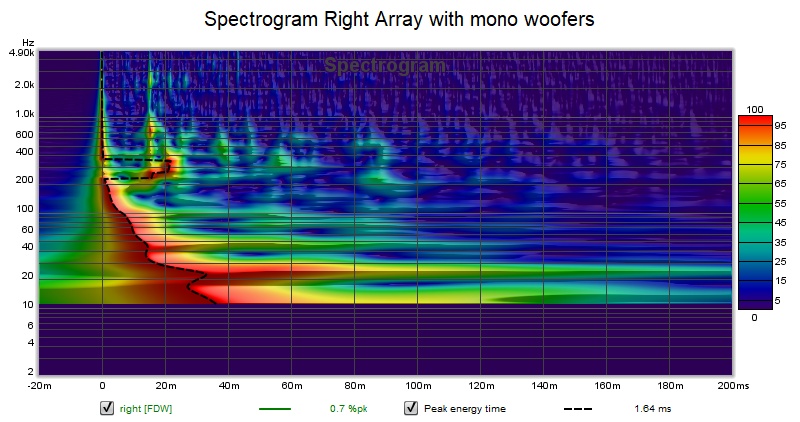
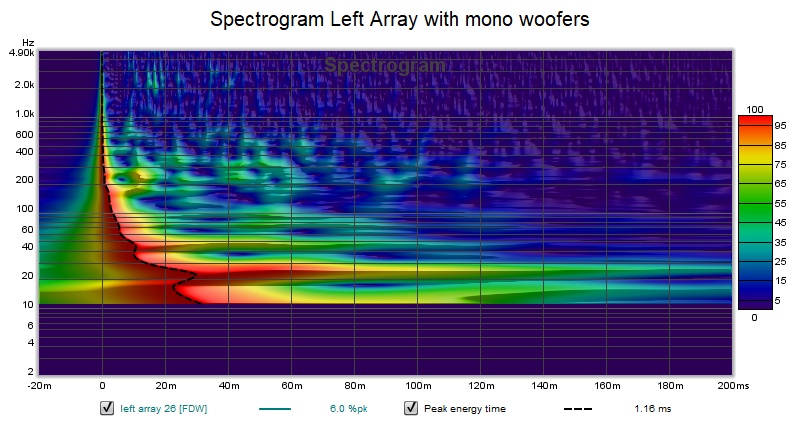
So the big difference was moving panels from rear wall to beside the left array but we still need more. Issues still apparent in the spectrogram.
These are good enough I'm encouraged to try DRC but its fighting back.
are here are the spectrograms
So the big difference was moving panels from rear wall to beside the left array but we still need more. Issues still apparent in the spectrogram.
These are good enough I'm encouraged to try DRC but its fighting back.
Attachments
Delaying the sub sounds logical. Phase rev effect is controversial but most likely necessary. Crossover freq and 1 octave around is most critical. The problem is what happens to other frequencies...
About bass traps. Think about how a mode is born and how and where it lives. The wavelength is several meters and by nature a standing wave (mode) needs opposing large surfaces to live and gain amplitude. It also means that if you want to tame it, you must cover major area or either of opposing walls (where maximum amplitude happens). A trap makes only a few % of the area of your side wall... And my logic calls for wideband absorbers.
One thing that strikes my eyes is lack of furniture in your garage. Perhaps you should consider to start collecting flea market sofas, beds and recliners, so it would look like a normal carage 😉
About bass traps. Think about how a mode is born and how and where it lives. The wavelength is several meters and by nature a standing wave (mode) needs opposing large surfaces to live and gain amplitude. It also means that if you want to tame it, you must cover major area or either of opposing walls (where maximum amplitude happens). A trap makes only a few % of the area of your side wall... And my logic calls for wideband absorbers.
One thing that strikes my eyes is lack of furniture in your garage. Perhaps you should consider to start collecting flea market sofas, beds and recliners, so it would look like a normal carage 😉
Last edited:
I'm sure you can imagine what I've gone through to get to this state of garage. That might be my biggest accomplishment.
There are modes and there are boundary interference nulls and I understand the difference but initially didn't distinguish between them correctly. So I will work on the bass trapping after I'm sure I've got the last boundary null covered. A set of limp membrane absorbers on the block walls should do the trick iff I can get the tuning right.
There are modes and there are boundary interference nulls and I understand the difference but initially didn't distinguish between them correctly. So I will work on the bass trapping after I'm sure I've got the last boundary null covered. A set of limp membrane absorbers on the block walls should do the trick iff I can get the tuning right.
- Home
- Loudspeakers
- Full Range
- Full range line array for wall or corner placement
